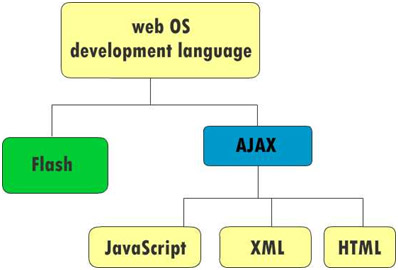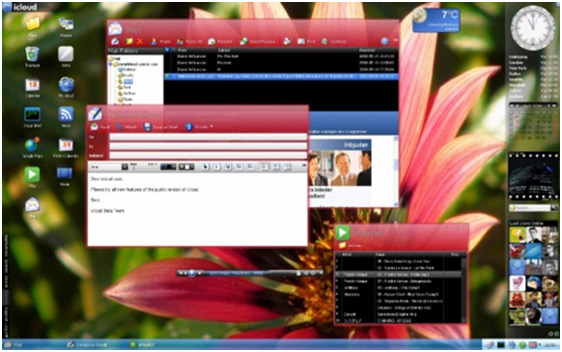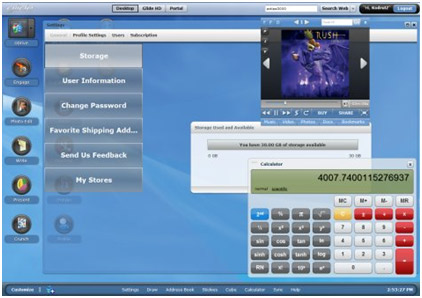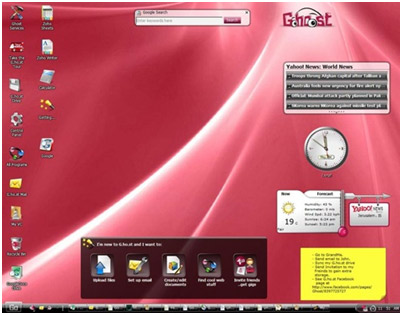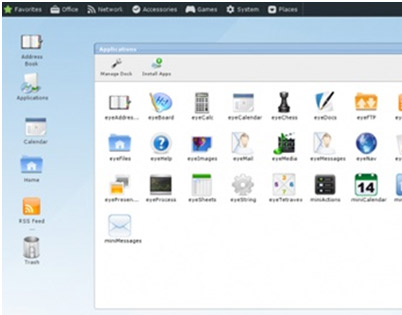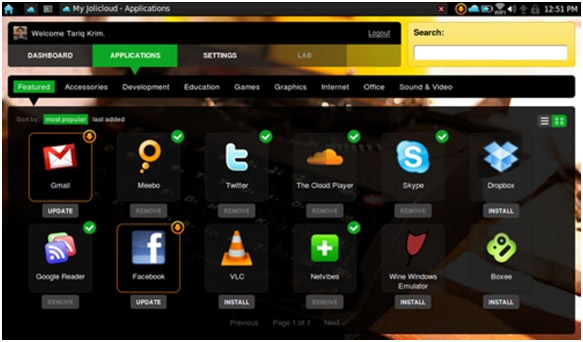Web Operating System is an Internet service through which a user can access his computer data remotely, anywhere, on any computer and in any part of the planet where the Internet is available. 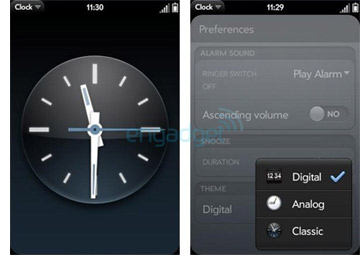
Figure 1: A representational image of the Web OS
It was called “Web Operating System” because they are present on the web and not on the user's computer, all data is stored on the Web OS provider's servers. Recently there was a big uproar on the internet about the word “iCloud”. It was the introduction of yet another operating system in the category of web operating systems. Web Operating Systems ( webOS ) was introduced as the idea that it would be possible to play with the application, store data and share it on the Internet from anywhere in the world. The same happens with a web operating system. Today, web operating systems are capable of storing large amounts of user data, up to 50 GB, providing a very simplified and user-friendly interface. You can share files, listen to music, read news and do many other things depending on the diversity and richness of the web operating system used by the user. In one line, “We have internet on the computer. So, web OS is a computer on the internet.”
Myths about WebOS
As the Earth's entropy increases day by day, so does the confusion in technology. Here are some of the many confusions or misunderstandings in the word “web OS”. One of the basic myths is: “Are OS and Web OS the same thing?” The answer is “NO”, not at all. Operating systems were built to communicate between the application and the computer hardware. It deals with the internal operations performed inside the computer. It includes task scheduling, multitasking, resource utilization, etc. But on the other hand, WebOS are the operating systems made up of a rich user interface that tries to imitate the look and feel of an operating system. Another myth related to web OS is its confusion with another word “webOS”. webOS is actually an operating system developed on Linux for palm mobile devices.
How does the Web operating system work?
Before we get into the details of servers and cloud computing, let's start locally. Consider the case of the computers we have. Computer consists of various applications to work such as calculator to calculate, calendar to schedule, clock, games and many other applications. Apart from these applications, we also have various data like movies, memories, music and files, etc., which we store on the computer's hard drive. We communicate with the computer through the user interface that is now before your eyes (if you are viewing this page on a computer). If we want to share any data, the internet is involved. Sharing can be done through various websites available on the web. So this is how a local computer with a normal user works. Now consider yourself a computer user working in the office. Suddenly your boss calls you to show him some random file (sometimes they like to make people feel inconvenient). But you forgot to bring it. The file is on your home PC's hard drive and cannot be teleported from there to your office computer in the air. This is the situation where most brains think if there could be some method by which they could access their local content anywhere. This problem was solved by programmers by introducing the concept of “Web OS”.
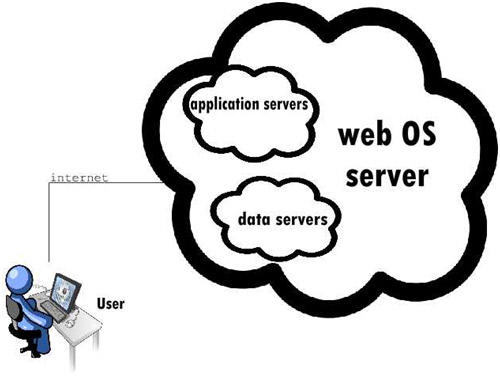
Figure 2: A diagram illustrating the WebOS concept
WebOS are the dynamic computers. The applications, hard drive and operating systems are all present on the servers from which they are operated. The OS web service provider has different spaces for application and database access. The user receives a graphical interface similar to that of their PC. This operating system consists of an application section like calendar, clock, calculator, document editors, etc., then there is a section for data storage where the user can store data, and there are many other sections depending on the web operating system. Any content the user wants to store is stored on the servers hard drive. As the terminology itself says, the web operating system makes use of the web to connect and upload files to the client server.
As the files are now stored on the server, the user can now use them remotely from anywhere on the planet. All you need is internet and a computer and everything is done. The user must turn on the computer, start the internet and access the respective operating system website or download the operating system application (if it is not on the remote computer) and browse the data. Simple!
How to Get Started with Web OS
How to get started with Web OS?
Getting started with the web operating system is very simple. It's as easy to use as signing up for any social networking site. Take a look-
Step 1 – Sign Up: Go to the web operating system provider's website and create an account by signing up. This creates space for the user on the server. There are two cases, sometimes the user needs to download a web operating system application before signing up and in other case the user can sign up directly on the provider's website.
Step 2 –Get Started: Next comes the last step, the user can now play with the applications offered by the provider, save data in them and do many other things depending on the web operating system the user is using.
Step 3 – Have your data remotely anywhere: To collect data from the web operating system, the user must download the same web operating system application on the computer they are using (in this case) or they can simply log in to the provider's website and have your data anytime, anywhere on the planet.
Developing a Web Operating System
Developing a Web Operating System:
The main concern for a web operating system, whether online or application based, is to have a lightweight user interface in the sense that it should take up less space, load quickly and provide a user-friendly interface. These concerns have been addressed by applications such as Flash and XML scripts.
Fig. 3: A flowchart showing different web operating system development languages
Flash is a very popular web development tool. The fact that it is so popular is because it offers the user the possibility of making interactive applications using JavaScript and also allows the user to make animations. Flash uses vector graphics to build any application or animation. Vector graphics take any photo or image in the form of shapes rather than pixel by pixel as it requires very less space on the system and also on the internet. Effective use of flash can be seen on any video streaming website where the browser uses flash player to play the video. Because of these interactive features of flash, it is being used to create an interface for the web operating system.
Another approach to creating a web operating system is through XML coding or in more technical terms it is called AJAX which stands for “ Asynchronous JavaScript and XML” this is a very effective alternative to Flash. In fact, AJAX is a package of different languages used for web development like HTML (Hyper Text Markup Language), JavaScript coding, CSS (Cascading Style Sheets), and eXtensible Markup Language.
HTML is not a coding language, it is a markup language where different tags are used for different needs. The browser reads these tags and provides the appropriate result. Since the interface is developed using HTML, it must also be beautiful, so to bring adjustments in the HTML-coded web operating system, CSS which stands for “Cascading Style Sheets” is used which increases the appearance of the page from the web. Now that our user-friendly interface has been shaped, it needs to communicate with the servers. To fill this vacancy, JavaScript is used, which is a language used to communicate with servers. An application installed on the computer connects to the server using JavaScript. It also allows you to send specific information to specific servers. Now that we have successfully established communication between the application and the server, there is one more problem, that is, no one knows which file is related to what kind of information, that is, the application file must be related to the application server and the data must relate to the data server, to solve this problem XML is used. This keeps the files and information related to it in your virtual box in a systematic way. The best feature of AJAX is its asynchronous communication. As a result, information can be sent and received between the computer and the server in small packets whenever necessary, thus using resources.
This is how a web operating system is developed. Another capability of Flash and AJAX is that they are cross-platform languages and can be used on any operating system.
Features and applications
Features and applications:
Different services offered by the web operating system are listed below:
· store music
· Photos
· Forms
· Documents
· Favorites
· Sticky notes
· Grades
· E-books
· Contacts
· Email client
· Calendar
· Calculator
Below is the list of preferred and feature-packed web operating systems:
1. iCloud : Within a week of its launch, there were over 20 million users worldwide. The reason was the various services they provided. Through iCloud, users can manage the content of their portable devices such as iPhone and iPad. The user has the power to access virtually all of their data from anywhere. Additionally, the user can have 50 GB of storage space. A typical screenshot of the iCloud interface is shown below:
Fig. 4: A representative image of the iCloud interface
two. Glide OS : Glide OS is a very famous operating system. It offers a Windows computer-like interface and accessibility to access it on computers as well as mobile phones. It gives the user 10 GB of space to store data. A screenshot of glide OS is shown below:
Fig. 5: A screenshot of the Glide OS operating system
3. GHOST : G.HO.ST stands for “Global Hosted Operating System”, it is a web operating system very similar to a computer. At first glance, it completely resembles a Windows computer, which makes it suitable for users of all types, that is, from old to young. G.HO.ST offers 15GB free space for data storage and a very professional sharing mechanism. A typical GHOST screenshot is shown below:
Fig. 6: A representational image of the global hosted operating system
Resources and applications, continued.
4. Eye OS : Eye OS is among the first web operating systems and since its inception it is becoming more and more powerful due to its worldwide development by the developer community. The latest version available is Eye OS 2.2.0. One of the main features that differentiates it from other web operating systems is that it can be used by creating an account on the Eye OS server or the user can download its application and use it on their own computer. If you are developing eye OS, they provide an eye OS toolkit that includes library resources and development tools. It offers many types of applications including document editor, PDF reader, etc. A screenshot of the operating system GUI is shown below:
Fig. 7: A screenshot of the Eye OS operating system
5. JoliCloud : JoliCloud is a web operating system that has its diversion into the social network. In addition to the apps it offers, it offers a rich interface to connect all social media in one place. It was basically developed with touch pads and tablet PC in mind. A screenshot of the JoliCloud app is shown below:
Fig. 8: A representational image of the JoliCloud operating system
Conclusion:
The Earth is shrinking at a great rate if we relate to our communication power, and as we all know that shrinkage is inversely proportional to complexity, the introduction of new virtual world ideas like web OS allows us to easily deal with the complexities and in become more social.


